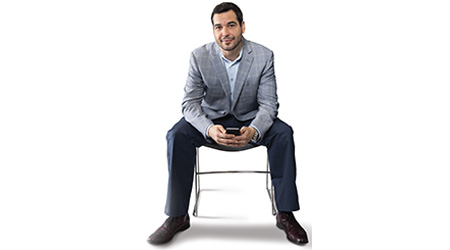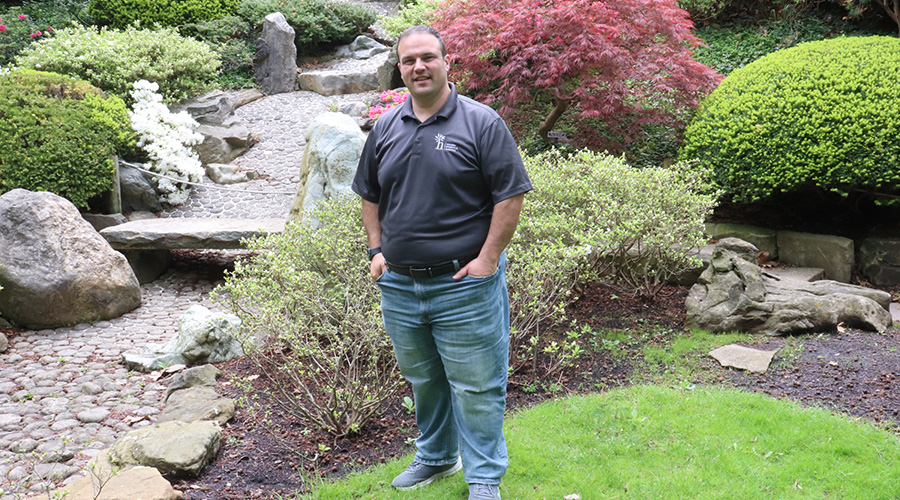 Working to really understand what the facility department is trying to accomplish is one way Shane Riggio, VP of IT at Macerich, leads his department into true partnership with FM. Brandon Sullivan Photography
Working to really understand what the facility department is trying to accomplish is one way Shane Riggio, VP of IT at Macerich, leads his department into true partnership with FM. Brandon Sullivan Photography IT and Facilities Management: Case Study In How To Collaborate Successfully
First of a two-part article profiling Shane Riggio, vice president of IT at Macerich.
For many facility managers, it may sound like a dream: having an IT department that makes listening to facility management needs a priority, that understands building systems, that wants to help accelerate improvements in buildings, not be a bottleneck. Shane Riggio sees no reason for a working relationship like that to be a dream. In fact, as vice president of IT at Macerich, Riggio sees those principles as basic operating requirements for his department.
Macerich is a real estate investment trust that owns 56 million square feet of real estate, most of it regional shopping centers. As is the case with other real estate companies, buildings are at the heart of Macerich’s mission. That makes Macerich very different from most other S&P 500 companies (Macerich is on that exclusive list) as well as from hospitals, universities, government bodies, and most other types of organizations that own buildings. As a result, IT at Macerich has an incentive to support facility needs in a way that isn’t true of, say, a big insurance company.
But Riggio’s experiences have plenty to teach facility managers in organizations where buildings aren’t a natural IT priority. That’s because developments in facility technology are driving facility management and IT closer together. Experts see a future in which facility managers need — and get — much more IT support for advanced technologies to take advantage of the Internet of Things and big data opportunities. At Macerich, that future is already well underway. Wherever they work, facility managers who learn to work effectively with IT will be doing themselves and their organizations a big favor.
Understanding the business
When Riggio arrived at Macerich in October 2004, he had the specific task of stabilizing the data network at the company’s corporate location. The REIT had purchased Westcor Realty Limited Partnership in July 2002, and it was assimilating the information technology departments for both companies.
Riggio brought a diverse IT background to Macerich. He had been a project manager and senior internetworking engineer for Data Systems Worldwide for three years where among the projects he managed was the local and wide area network upgrade for the city of Beverly Hills and the City of Burbank’s local and wide area network audits. He also assisted with upgrading the local metropolitan area networks for Warner Brothers Studios in New York and Los Angeles. Before that, he worked as a quality assurance engineer at Nortel Networks and served in the Marines, where he was responsible for supporting tactical and strategic communications, for which he received awards and commendations.

(The smart building infrastructure program helps Macerich use facility data to achieve sustainability goals. Credit: Macerich)
But as Riggio worked through the technical issues involved in combining two separate IT systems, he also had a broader vision for IT: Understand the business that IT is supporting. That was the philosophy he had used successfully as a consultant when communicating with colleagues in property management, development/design, and construction. “I thought it was a great philosophy to instill in our staff,” Riggio says.
Riggio strongly believes that IT staffers have to be good listeners, and part of that is making colleagues comfortable and not using confusing language, Riggio says. Many IT staffers were so-called geeks in school and so it’s not uncommon for Riggio to see those staffers want to push back and sometimes be bullies.
“And I really try to pay attention to that because that will take the confidence out of a facilities manager quickly,” he says. “That is a challenge, so I find myself taking IT guys aside and saying to them that it’s time to listen. Any time we feel like we are getting ahead of ourselves, we are wrong. So let us listen.”
“Managing and operating real estate assets in today’s age requires you to use technology, and it’s good to have someone who wants to work with you,” Riggio says. “We’ll put someone with you who understands you and can make your life easier.”
It took a little while for everyone at Macerich to get used to the idea that it was important for IT to develop a good relationship with other departments. The staff on the construction side was used to dealing with third-party consultants, so the approach was very new to them in the early stages, Riggio says. Riggio’s personal style — easygoing, extroverted, eager to provide support, certainly not the stereotypical introverted IT person — certainly helped. So did his use of layman’s terms to demystify IT concepts.
“And once I won over the department heads with the why and what’s in it for them, it was easier,” he says. “The hard part is really bridging these gaps between the departments and not the IT.”
Riggio’s unique approach hasn’t gone unnoticed by his colleagues. He was one of the first people that Joseph Venne met when Venne joined Macerich eight years ago. As vice president of operations for Macerich, Venne crosses paths with Riggio regularly.
Venne’s experience with other IT departments had been mixed at best, bad at worst. IT would be involved but it was rarely a good partner because it didn’t listen, instead telling people what to do and leaving it at that, he says.
“That was what was most shocking about Shane,” Venne says. “Much of this is from Shane’s influence. The IT department works harder to understand what you want to do than what it takes to do it. His folks want to understand what you want done, and then they look at how technology can help accomplish that goal.”
The benefit of having a solid working relationship with IT is that the department will work with an employee to make sure the approach being taken to a matter is the best one, Venne says. “And it may be that your approach is not the best way,” he says. “And when you work with IT, you may find that the 7-step process you thought was needed can actually be done in three steps and that creates efficiencies through the use of technology. If I can automate something, it reduces the amount of time that people need to get involved, freeing you up to do other things.”
Related Topics:














